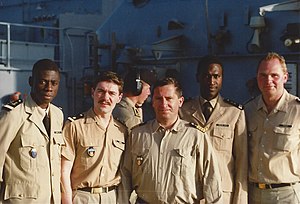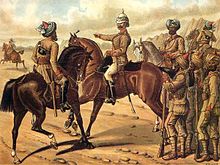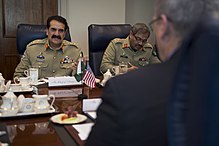| Revision as of 19:19, 1 January 2020 editPeaceray (talk | contribs)Autopatrolled, Administrators95,390 edits Reverted 2 pending edits by 103.69.27.87 to revision 932422531 by Mike Peel: Unexplained removal of content. Possible WP:POV editing.← Previous edit | Latest revision as of 01:17, 11 January 2025 edit undoSurv1v4l1st (talk | contribs)Extended confirmed users, Pending changes reviewers, Rollbackers26,480 edits +WL | ||
| (135 intermediate revisions by 89 users not shown) | |||
| Line 1: | Line 1: | ||
| {{Short description|Color of tan commonly found in arid-region military uniforms}} | |||
| {{pp-pc1}} | {{pp-pc1}} | ||
| {{about|khaki as a color}} | {{about|khaki as a color}} | ||
| {{Use American English|date=October 2013}} | {{Use American English|date=October 2013}} | ||
| ] | ] | ||
| ''' |
The color '''khaki''' ({{IPAc-en|uk|ˈ|k|ɑː|k|i}}, {{IPAc-en|us|ˈ|k|æ|k|i}}) is a light shade of tan with a slight yellowish tinge. | ||
| https://web.archive.org/web/20130628074235/http://www.paintassistant.com/rybrgb.html</ref> | |||
| Khaki has been used by many armies around the world for uniforms, |
Khaki has been used by many armies around the world for uniforms and equipment, particularly in arid or desert regions, where it provides ] relative to sandy or dusty terrain. It has been used as a color name in English since 1848 when it was introduced as a military uniform.<ref>Maerz and Paul ''A Dictionary of Color'' New York:1930 McGraw-Hill Page 197; Color Sample of Khaki: Page 49 Plate 13 Color Sample J7</ref> In Western fashion, it is a standard color for ] dress trousers for civilians, which are also often called ''khakis''. | ||
| In British English and some other Commonwealth usage, ''khaki'' may also refer to a shade of green known as ].<ref>{{cite web |title=Khaki entry in Cambridge Dictionary |url=https://dictionary.cambridge.org/dictionary/english/khaki |website=Cambridge Dictionary |access-date=25 November 2020}}</ref><ref>{{cite web |title=Khaki definition and meaning {{!}} Collins English Dictionary |url=https://www.collinsdictionary.com/dictionary/english/khaki |website=www.collinsdictionary.com |language=en}}</ref><ref>{{cite news |last1=Sykes |first1=Pandora |title=Wardrobe Mistress: how to tackle the khaki jacket |url=https://www.thetimes.co.uk/article/wardrobe-mistress-how-to-tackle-the-khaki-jacket-8npv5ksmh |website=] |publisher=The Times (of London) |access-date=22 December 2020 |language=en}}</ref> | |||
| In Western fashion, it is a standard color for ] dress trousers for civilians, which are also often called ''khakis''. | |||
| ==Etymology== | ==Etymology== | ||
| ''Khaki'' is a ] from |
''Khaki'' is a ] from ] ] 'soil-colored', which in turn comes from ] ] {{IPA|fa|χɒːk|}} ''khāk'' 'soil' + {{lang|fa|ی}} (adjectival attributive suffix); it came into English via the ].<ref>; TheFreeDictionary; Free Online Dictionary, Thesaurus, and Encyclopedia</ref><ref name="StClair2">{{Cite book|title=The Secret Lives of Colour|last=St. Clair|first=Kassia|publisher=John Murray|year=2016|isbn=9781473630819|location=London|pages=240–241|oclc=936144129}}</ref> | ||
| ==Origin== | ==Origin== | ||
| ] |
] (Infantry & Cavalry) by ]]] | ||
| ⚫ | Khaki was first worn in the ] that was raised in December 1846 by Henry Lawrence (1806–1857),<ref name="StClair2" /> |
||
| ⚫ | Khaki was first worn as a uniform in the ] that was raised in December 1846 by ] (1806–1857),<ref name="StClair2" /> agent to the Governor-General for the North-West Frontier and stationed in ]. Initially the border troops were dressed in their native costume, which consisted of a smock and white pajama trousers made of a coarse home-spun cotton, and a cotton turban, supplemented by a leather or padded cotton jacket for cold weather. In 1848, a khaki uniform was introduced.<ref>"Khaki Uniform 1848–49: First Introduction by Lumsden and Hodson", ''Journal of the Society for Army Historical Research'', 82 (Winter 2004) pp 341–347</ref> Subsequently, all regiments serving in the region, whether British or Indian, had adopted khaki uniforms for active service and summer dress. The original khaki fabric was a closely twilled cloth of ] or ]. | ||
| ⚫ | ==Military use== | ||
| ] | |||
| ⚫ | ==Military use== | ||
| ⚫ | The impracticality of traditional bright colors such as the ], especially for skirmishing, was recognised early in the 19th century.<ref>{{cite book|last1=Williams|first1=Cynric R.|title=Hamel, the Obeah man|date=1827|publisher=Hunt and Clarke|location=London|page=279|edition=1st|url=https://archive.org/stream/hamelobeahman00hamegoog#page/n624/mode/2up| |
||
| ] | |||
| ⚫ | The impracticality of traditional bright colors such as the ], especially for skirmishing, was recognised early in the 19th century.<ref>{{cite book|last1=Williams|first1=Cynric R.|title=Hamel, the Obeah man|date=1827|publisher=Hunt and Clarke|location=London|page=279|edition=1st|url=https://archive.org/stream/hamelobeahman00hamegoog#page/n624/mode/2up|access-date=3 February 2016}}"...A red-coat on one of these rocks will only be a mark for these rebels."</ref><ref>{{cite journal|title=The Army|journal=Blackwood's Edinburgh Magazine|volume=60|issue=370|page=144}} "...scarlet is unmilitary, first, because it is tawdry ; and secondly, as rendering the soldier, when isolated, an easier mark than a less glaring colour." (1846)</ref> A response to improved technologies such as ] and ], khaki could camouflage soldiers in the field of battle.<ref>{{cite book|last=Tynan|first=Jane|title=British Army Uniform and the First World War: Men in Khaki|year=2013|publisher=Palgrave MacMillan|location=London}}</ref><ref name="StClair2" /> | ||
| Khaki-colored uniforms were used officially by British troops for the first time during the ], when Indian troops traveled to Ethiopia.<ref>], ''Armies of the Raj'', 1989, page 75.</ref> Subsequently, the ] adopted khaki for colonial campaign dress and it was used in the ] (1884–89) and ] (1899–1902). These uniforms became known as ], versions of which are still part of the ]. | Khaki-colored uniforms were used officially by British troops for the first time during the ], when Indian troops traveled to Ethiopia.<ref>], ''Armies of the Raj'', 1989, page 75.</ref> Subsequently, the ] adopted khaki for colonial campaign dress and it was used in the ] (1884–89) and ] (1899–1902). These uniforms became known as ], versions of which are still part of the ]. | ||
| During the Second Boer War, the British forces became known as Khakis because of their uniforms. After victory in the war, the government called an election, which became known as the ], a term used subsequently for elections called to exploit public approval of governments immediately after military victories. | During the Second Boer War, the British forces became known as Khakis because of their uniforms.{{citation needed|date=February 2020}} After victory in the war, the government called an election, which became known as the ], a term used subsequently for elections called to exploit public approval of governments immediately after military victories. | ||
| The ] adopted khaki during the ] (1898), replacing their traditional blue field uniforms. The ] and ] followed suit, authorizing khaki field and work uniforms. | The ] adopted khaki during the ] (1898), replacing their traditional blue field uniforms. The ] and ] followed suit, authorizing khaki field and work uniforms. | ||
| ] | |||
| ⚫ | When khaki was adopted for the continental British ] in 1902, the shade chosen had a clearly darker and more green hue. This color was adopted with minor variations by all the British Empire |
||
| ⚫ | When khaki was adopted for the continental British ] in 1902, the shade chosen had a clearly darker and more green hue (see photo). This color was adopted with minor variations by all the British Empire armies. The 1902 US Army uniform regulations also adopted a similar shade for soldiers' winter service uniforms under the name ]. This shade of brown-green remained in use by many countries throughout the two World Wars. | ||
| ⚫ | ==Use in civilian clothing== | ||
| ⚫ | |||
| ⚫ | == Use in civilian clothing == | ||
| ⚫ | Following World War II, military-issue khaki-colored ] twill trousers became a common part of civilian clothing. Today, the term ''khakis'' is sometimes used to refer to the style of trousers, properly called chinos, regardless of their color. | ||
| ==Tones of khaki== | ==Tones of khaki== | ||
| Line 39: | Line 41: | ||
| ===Light khaki=== | ===Light khaki=== | ||
| {{infobox color | {{infobox color | ||
| | title= |
| title=Light Khaki | ||
| | hex=F0E68C | | hex=F0E68C | ||
| ⚫ | | source=]<ref name="css3-color">{{cite web|url=http://www.w3.org/TR/css3-color/#html4|title=CSS Color Module Level 3|first1=Tantek|last1=Çelik|first2=Chris|last2=Lilley|first3=L. David|last3=Baron|last4=W3C|first5=L. David|last5=Baron|date=19 June 2018|website=www.w3.org|access-date=22 October 2018}}</ref> | ||
| | r=240|g=230|b=140 | |||
| | c= 0|m= 4|y= 42|k= 6| | |||
| | h=54|s=41|v=94 | |||
| ⚫ | | source=]<ref name="css3-color">{{cite web|url=http://www.w3.org/TR/css3-color/#html4|title=CSS Color Module Level 3|first1=Tantek|last1=Çelik|first2=Chris|last2=Lilley|first3=L. David|last3=Baron |
||
| |isccname=Light greenish yellow}} | |isccname=Light greenish yellow}} | ||
| At right is displayed the color '''light khaki''' (also called khaki tan or just ]). | At right is displayed the color '''light khaki''' (also called khaki tan or just ]). | ||
| It corresponds to ''Khaki'' in the ].<ref name=css3>, retrieved 2010-09-12</ref> | |||
| {{-}} | {{-}} | ||
| Line 56: | Line 54: | ||
| | title=Khaki (HTML/CSS) | | title=Khaki (HTML/CSS) | ||
| | hex=C3B091 | | hex=C3B091 | ||
| | r=195|g=176|b=145 | |||
| | c= 0|m= 10|y= 26|k= 24 | |||
| | h=37|s=26|v=76 | |||
| | source=] | | source=] | ||
| | isccname=Grayish yellow | | isccname=Grayish yellow | ||
| Line 72: | Line 67: | ||
| | title=Dark Khaki | | title=Dark Khaki | ||
| | hex=BDB76B | | hex=BDB76B | ||
| | r=189|g=183|b=107 | |||
| | c= 0|m= 3|y= 43|k= 26 | |||
| | h=56|s=43|v=74 | |||
| | source=] | | source=] | ||
| | isccname=Moderate greenish yellow}} | | isccname=Moderate greenish yellow}} | ||
| At right is displayed the web color '''dark khaki'''.<ref name=css3 /> | At right is displayed the web color '''dark khaki'''.<ref name=css3>, retrieved 2010-09-12</ref> | ||
| It corresponds to ''Dark Khaki'' in the ]. | It corresponds to ''Dark Khaki'' in the ]. | ||
| {{-}} | |||
| ===Khaki green=== | |||
| {{infobox color | |||
| | title=Khaki green | |||
| | hex=728639 | |||
| | source= | |||
| | isccname=Pale olive brown}} | |||
| At right is displayed the color '''khaki green''', sometimes called simply ''khaki'' in ] countries. It is more commonly called ] or ]. | |||
| {{-}} | {{-}} | ||
| ==See also== | ==See also== | ||
| * ] | * ] | ||
| * ] | |||
| ==References== | ==References== | ||
| Line 89: | Line 93: | ||
| ==External links== | ==External links== | ||
| {{Wiktionary|khaki}} | *{{Wiktionary-inline|khaki}} | ||
| {{Commons cat|Khaki|lcfirst=yes}} | *{{Commons cat-inline|Khaki|lcfirst=yes}} | ||
| {{shades of brown}} | {{shades of brown}} | ||
| Line 97: | Line 101: | ||
| ] | ] | ||
| ] | ] | ||
| ] | |||
Latest revision as of 01:17, 11 January 2025
Color of tan commonly found in arid-region military uniformsThis article is about khaki as a color. For other uses, see Khaki (disambiguation).

The color khaki (UK: /ˈkɑːki/, US: /ˈkæki/) is a light shade of tan with a slight yellowish tinge.
Khaki has been used by many armies around the world for uniforms and equipment, particularly in arid or desert regions, where it provides camouflage relative to sandy or dusty terrain. It has been used as a color name in English since 1848 when it was introduced as a military uniform. In Western fashion, it is a standard color for smart casual dress trousers for civilians, which are also often called khakis.
In British English and some other Commonwealth usage, khaki may also refer to a shade of green known as olive drab.
Etymology
Khaki is a loanword from Urdu خاکی 'soil-colored', which in turn comes from Persian خاک [χɒːk] khāk 'soil' + ی (adjectival attributive suffix); it came into English via the British Indian Army.
Origin

Khaki was first worn as a uniform in the Corps of Guides that was raised in December 1846 by Henry Lawrence (1806–1857), agent to the Governor-General for the North-West Frontier and stationed in Lahore. Initially the border troops were dressed in their native costume, which consisted of a smock and white pajama trousers made of a coarse home-spun cotton, and a cotton turban, supplemented by a leather or padded cotton jacket for cold weather. In 1848, a khaki uniform was introduced. Subsequently, all regiments serving in the region, whether British or Indian, had adopted khaki uniforms for active service and summer dress. The original khaki fabric was a closely twilled cloth of linen or cotton.
Military use

The impracticality of traditional bright colors such as the red coat, especially for skirmishing, was recognised early in the 19th century. A response to improved technologies such as aerial surveillance and smokeless powder, khaki could camouflage soldiers in the field of battle.
Khaki-colored uniforms were used officially by British troops for the first time during the 1868 Expedition to Abyssinia, when Indian troops traveled to Ethiopia. Subsequently, the British Army adopted khaki for colonial campaign dress and it was used in the Mahdist War (1884–89) and Second Boer War (1899–1902). These uniforms became known as khaki drill, versions of which are still part of the uniforms of the British Army.
During the Second Boer War, the British forces became known as Khakis because of their uniforms. After victory in the war, the government called an election, which became known as the khaki election, a term used subsequently for elections called to exploit public approval of governments immediately after military victories.
The United States Army adopted khaki during the Spanish–American War (1898), replacing their traditional blue field uniforms. The United States Navy and United States Marine Corps followed suit, authorizing khaki field and work uniforms.

When khaki was adopted for the continental British Service Dress in 1902, the shade chosen had a clearly darker and more green hue (see photo). This color was adopted with minor variations by all the British Empire armies. The 1902 US Army uniform regulations also adopted a similar shade for soldiers' winter service uniforms under the name olive drab. This shade of brown-green remained in use by many countries throughout the two World Wars.
Use in civilian clothing
Following World War II, military-issue khaki-colored chino cloth twill trousers became a common part of civilian clothing. Today, the term khakis is sometimes used to refer to the style of trousers, properly called chinos, regardless of their color.
Tones of khaki
Light khaki
| Light Khaki | |
|---|---|
| Hex triplet | #F0E68C |
| sRGB (r, g, b) | (240, 230, 140) |
| HSV (h, s, v) | (54°, 42%, 94%) |
| CIELChuv (L, C, h) | (90, 62, 80°) |
| Source | X11 |
| ISCC–NBS descriptor | Light greenish yellow |
| B: Normalized to (byte) | |
At right is displayed the color light khaki (also called khaki tan or just tan).
Khaki
| Khaki (HTML/CSS) | |
|---|---|
| Hex triplet | #C3B091 |
| sRGB (r, g, b) | (195, 176, 145) |
| HSV (h, s, v) | (37°, 26%, 76%) |
| CIELChuv (L, C, h) | (73, 28, 61°) |
| Source | HTML/CSS |
| ISCC–NBS descriptor | Grayish yellow |
| B: Normalized to (byte) | |
This is the web color called khaki in HTML/CSS.
The color shown at right matches the color designated as khaki in the 1930 book A Dictionary of Color, the standard for color nomenclature before the introduction of computers.
Dark khaki
| Dark Khaki | |
|---|---|
| Hex triplet | #BDB76B |
| sRGB (r, g, b) | (189, 183, 107) |
| HSV (h, s, v) | (56°, 43%, 74%) |
| CIELChuv (L, C, h) | (73, 52, 82°) |
| Source | X11 |
| ISCC–NBS descriptor | Moderate greenish yellow |
| B: Normalized to (byte) | |
At right is displayed the web color dark khaki.
It corresponds to Dark Khaki in the X11 color names.
Khaki green
| Khaki green | |
|---|---|
| Hex triplet | #728639 |
| sRGB (r, g, b) | (114, 134, 57) |
| HSV (h, s, v) | (76°, 57%, 53%) |
| CIELChuv (L, C, h) | (53, 48, 101°) |
| Source | wikimix |
| ISCC–NBS descriptor | Pale olive brown |
| B: Normalized to (byte) | |
At right is displayed the color khaki green, sometimes called simply khaki in Commonwealth countries. It is more commonly called olive green or olive drab.
See also
References
- Maerz and Paul A Dictionary of Color New York:1930 McGraw-Hill Page 197; Color Sample of Khaki: Page 49 Plate 13 Color Sample J7
- "Khaki entry in Cambridge Dictionary". Cambridge Dictionary. Retrieved 25 November 2020.
- "Khaki definition and meaning | Collins English Dictionary". www.collinsdictionary.com.
- Sykes, Pandora. "Wardrobe Mistress: how to tackle the khaki jacket". The Times. The Times (of London). Retrieved 22 December 2020.
- Dictionary Meaning: Khaki; TheFreeDictionary; Free Online Dictionary, Thesaurus, and Encyclopedia
- ^ St. Clair, Kassia (2016). The Secret Lives of Colour. London: John Murray. pp. 240–241. ISBN 9781473630819. OCLC 936144129.
- "Khaki Uniform 1848–49: First Introduction by Lumsden and Hodson", Journal of the Society for Army Historical Research, 82 (Winter 2004) pp 341–347
- Williams, Cynric R. (1827). Hamel, the Obeah man (1st ed.). London: Hunt and Clarke. p. 279. Retrieved 3 February 2016."...A red-coat on one of these rocks will only be a mark for these rebels."
- "The Army". Blackwood's Edinburgh Magazine. 60 (370): 144. "...scarlet is unmilitary, first, because it is tawdry ; and secondly, as rendering the soldier, when isolated, an easier mark than a less glaring colour." (1846)
- Tynan, Jane (2013). British Army Uniform and the First World War: Men in Khaki. London: Palgrave MacMillan.
- Byron Farwell, Armies of the Raj, 1989, page 75.
- Çelik, Tantek; Lilley, Chris; Baron, L. David; W3C; Baron, L. David (19 June 2018). "CSS Color Module Level 3". www.w3.org. Retrieved 22 October 2018.
{{cite web}}: CS1 maint: numeric names: authors list (link) - CSS3 Color Module, retrieved 2010-09-12
External links
| Shades of yellow | |||||||||||||||||||||||||||||||||||||||||||||||||||||||||||||||||||||||||||||||||||||||||||||||||||||||||
|---|---|---|---|---|---|---|---|---|---|---|---|---|---|---|---|---|---|---|---|---|---|---|---|---|---|---|---|---|---|---|---|---|---|---|---|---|---|---|---|---|---|---|---|---|---|---|---|---|---|---|---|---|---|---|---|---|---|---|---|---|---|---|---|---|---|---|---|---|---|---|---|---|---|---|---|---|---|---|---|---|---|---|---|---|---|---|---|---|---|---|---|---|---|---|---|---|---|---|---|---|---|---|---|---|---|
| |||||||||||||||||||||||||||||||||||||||||||||||||||||||||||||||||||||||||||||||||||||||||||||||||||||||||
| A typical sample is shown for each name; a range of color-variations is commonly associated with each color-name. | |||||||||||||||||||||||||||||||||||||||||||||||||||||||||||||||||||||||||||||||||||||||||||||||||||||||||